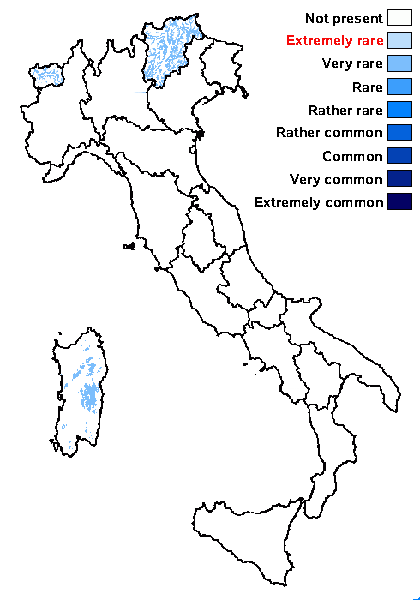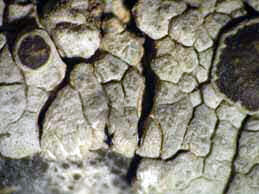Lobothallia praeradiosa (Nyl.) Hafellner
Acta Bot. Malacitana, 16, 1: 138, 1991. Basionym: Lecanora praeradiosa Nyl. - Flora, 67: 389, 1884.
Synonyms: Aspicilia praeradiosa (Nyl.) Poelt & Leuckert
Distribution: N - TAA (Navarro-Rosinés & Hafellner 1996), VA (Piervittori & Isocrono 1999). C - Sar (B 60 0197145).
Description: Thallus crustose-placodioid, episubstratic, 0.5-1 mm thick centrally, closely attached, areolate in central parts, yellowish white, grey or brownish grey, often grey-pruinose, not changing colour when wet, forming regular to very irregular rosettes. Central areoles 0.5-1 mm wide, flat to convex; marginal lobes contiguous, radiating but often irregularly arranged, flat to slightly convex, up to 3-6 mm long and 0.5-1.3 mm wide. Upper cortex brown, usually inspersed with abundant, small dark granules soluble in K, overlain by a thin epinecral layer; medulla white, rather loose, I-: lower cortex absent or poorly developed. Apothecia lecanorine, 0.5-1.5(-2) mm across, adnate to sessile, with a brown to black, flat to convex, usually epruinose disc, and a 0.1(-0.3) mm thick, entire to flexuose, persistent thalline margin. Thalline exciple corticate, paraplectenchymatous; algal layer extending below the hypothecium; epithecium pale brown, usually inspersed with dark red-brown granules and covered by layer of coarse hyaline granules, N-; hymenium colourless, 70-90 µm high, I+ blue; paraphyses submoniliform in upper part, the apical cells short-clavate, 2-3 µm wide; hypothecium colourless, I+ blue. Asci 8-spored, oblong-ellipsoid, the thin outer coat K/I+ blue, the wall and apical dome K/I-. Ascospores 1-celled, hyaline, broadly ellipsoid to subglobose, (8-)9-13(-15) x 6-10 µm Photobiont chlorococcoid. Spot tests: K+ yellow turning red (needle-like crystals), C-, KC-, P+ orange, or P-. Chemistry: norstictic and constictic acids. Note: on basic siliceous rocks, especially calciferous schists, mostly restricted to dry-warm Alpine valleys.
Growth form: Crustose placodiomorph
Substrata: rocks
Photobiont: green algae other than Trentepohlia
Reproductive strategy: mainly sexual
Subcontinental: restricted to areas with a dry-subcontinental climate (e.g. dry Alpine valleys, parts of Mediterranean Italy)
Commonnes-rarity: (info)
Alpine belt: absent
Subalpine belt: extremely rare
Oromediterranean belt: absent
Montane belt: very rare
Submediterranean belt: absent
Padanian area: absent
Humid submediterranean belt: absent
Humid mediterranean belt: absent
Dry mediterranean belt: absent

Predictive model
Growth form: Crustose placodiomorph
Substrata: rocks
Photobiont: green algae other than Trentepohlia
Reproductive strategy: mainly sexual
Subcontinental: restricted to areas with a dry-subcontinental climate (e.g. dry Alpine valleys, parts of Mediterranean Italy)
Commonnes-rarity: (info)
Alpine belt: absent
Subalpine belt: extremely rare
Oromediterranean belt: absent
Montane belt: very rare
Submediterranean belt: absent
Padanian area: absent
Humid submediterranean belt: absent
Humid mediterranean belt: absent
Dry mediterranean belt: absent

Predictive model
 Index Fungorum
Index Fungorum
 GBIF
GBIF


